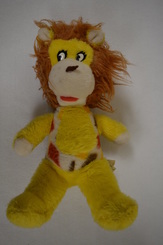
“Over the years I gave away all of my other stuffed animals. Leo’s the only one who survived the purge. Aunt Ursula was close to my grandmother, and I was really close to my grandmother. I guess that’s why Leo was more special than the others.”
This stuffed lion – “Leo” – was given to Rafik by his Aunt Ursula.
I’ve always known where he came from, which was my Aunt Ursula. I remember her getting off this bus or train or something, and pulling out Leo and saying, ‘This is for you.’ I was maybe five.
Ursula wasn’t a biological relation, but a friend of his grandmother.
Among the types of folks that I grew up with, there were lots of aunts and uncles who weren’t related to you. So Aunt Ursula was this woman I only remember meeting once or twice, but she was a friend of my grandmother’s from New York. I don’t know much about the relationship, really.
While Aunt Ursula may not have been a central figure in his young life, Leo arrived at a critical junction -- just as Rafik was moving from a segregated to an integrated neighborhood.
I initially grew up in an all-Black neighborhood near Hyattsville, Maryland. And I loved it. When I was about five my parents decided the schools were terrible. So, we moved. And we went from an all-black neighborhood to Silver Spring — which was a great place to grow up and experience different cultures all in one community, but it was strange.I felt a lot like an outsider from that point. Leo was always there, as this critter who made me feel comfortable and comforted.
In his new surroundings, Rafik became acutely aware that some people were treated differently than others.
As a kid you never want to be different, and I felt different often. I remember there was this girl, Jennifer Sowinski, and she was really popular. And in art class one day I picked up this can of purple paint and shook it and the lid flew off. Jennifer’s behind me and facing the other way, and purple paint goes down the back of her long, blonde hair. Just covered. And it’s that thick, oil based paint that you can’t wash out. And everybody treated me like I was the devil. Because not only had paint gone across the room and landed on someone, but it was Jennifer Sowinski. And even Mr. Schneider, who was nice, was like, ‘What did you do that for!? That’s Jennifer!’ And I was traumatized.
The first time I got detention was so lame! There were these big erasers. And I remember I was playing with somebody’s and it broke. And Miss Leslie was so angry that she gave me detention. And I was like, ‘This wouldn’t have happened if I was Jennifer Sowinski.’
Around the same period I was at Roy Rogers Restaurant. And a couple of kids with disabilities came in. My sister had never seen anyone disabled in that way, and so she was pointing at them. And I remember being really angry with my little sister and feeling a kinship with the kids, because I knew that people looked at them like that all the time.
Perhaps his grandmother’s stories played an equal, if not more important role, in developing his interest in fighting for social equality, as both a personal passion and as a career.
I remember my grandma telling me the story of meeting Thurgood Marshall – and she met him in the context of fighting for equal pay for black teachers in Maryland. She told me stories of what she had to endure, and what my mother had to endure because she grew up during segregation too, and that combined with me feeling on the margins I think to make me more acutely aware of injustice. I remember stuff like that. Which I think probably informed what I do now. My research is on social inequality for the most part, and how people on the margins don’t really have voice.